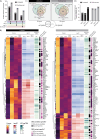Characterizing the regulatory effects of H2A.Z and SWR1-C on gene expression during hydroxyurea exposure in Saccharomyces cerevisiae
- PMID: 39836664
- PMCID: PMC11761084
- DOI: 10.1371/journal.pgen.1011566
Characterizing the regulatory effects of H2A.Z and SWR1-C on gene expression during hydroxyurea exposure in Saccharomyces cerevisiae
Abstract
Chromatin structure and DNA accessibility are partly modulated by the incorporation of histone variants. H2A.Z, encoded by the non-essential HTZ1 gene in S. cerevisiae, is an evolutionarily conserved H2A histone variant that is predominantly incorporated at transcription start sites by the SWR1-complex (SWR1-C). While H2A.Z has often been implicated in transcription regulation, htz1Δ mutants exhibit minimal changes in gene expression compared to wild-type. However, given that growth defects of htz1Δ mutants are alleviated by simultaneous deletion of SWR1-C subunits, previous work examining the role of H2A.Z in gene expression regulation may be confounded by deleterious activity caused by SWR1-C when missing its H2A.Z substrate (apo-SWR1-C). Furthermore, as H2A.Z mutants only display significant growth defects in genotoxic stress conditions, a more substantive role for H2A.Z in gene expression may only be uncovered after exposure to cellular stress. To explore this possibility, we generated mRNA transcript profiles for wild-type, htz1Δ, swr1Δ, and htz1Δswr1Δ mutants before and after exposure to hydroxyurea (HU), which induces DNA replication stress. Our data showed that H2A.Z played a more prominent role in gene activation than repression during HU exposure, and its incorporation was important for proper upregulation of several HU-induced genes. We also observed that apo-SWR1-C contributed to gene expression defects in the htz1Δ mutant, particularly for genes involved in phosphate homeostasis regulation. Furthermore, mapping H2A.Z incorporation before and after treatment with HU revealed that decreases in H2A.Z enrichment at transcription start sites was correlated with, but generally not required for, the upregulation of genes during HU exposure. Together this study characterized the regulatory effects of H2A.Z incorporation during the transcriptional response to HU.
Copyright: © 2025 Brewis et al. This is an open access article distributed under the terms of the Creative Commons Attribution License, which permits unrestricted use, distribution, and reproduction in any medium, provided the original author and source are credited.
Conflict of interest statement
The authors have declared that no competing interests exist.
Figures







Similar articles
-
The SWR1 histone replacement complex causes genetic instability and genome-wide transcription misregulation in the absence of H2A.Z.PLoS One. 2010 Aug 12;5(8):e12143. doi: 10.1371/journal.pone.0012143. PLoS One. 2010. PMID: 20711347 Free PMC article.
-
NuA4-dependent acetylation of nucleosomal histones H4 and H2A directly stimulates incorporation of H2A.Z by the SWR1 complex.J Biol Chem. 2010 May 21;285(21):15966-77. doi: 10.1074/jbc.M110.117069. Epub 2010 Mar 23. J Biol Chem. 2010. PMID: 20332092 Free PMC article.
-
What makes a histone variant a variant: Changing H2A to become H2A.Z.PLoS Genet. 2021 Dec 6;17(12):e1009950. doi: 10.1371/journal.pgen.1009950. eCollection 2021 Dec. PLoS Genet. 2021. PMID: 34871303 Free PMC article.
-
Variation on a theme: Evolutionary strategies for H2A.Z exchange by SWR1-type remodelers.Curr Opin Cell Biol. 2021 Jun;70:1-9. doi: 10.1016/j.ceb.2020.10.014. Epub 2020 Nov 17. Curr Opin Cell Biol. 2021. PMID: 33217681 Review.
-
The specificity of H2A.Z occupancy in the yeast genome and its relationship to transcription.Curr Genet. 2020 Oct;66(5):939-944. doi: 10.1007/s00294-020-01087-7. Epub 2020 Jun 14. Curr Genet. 2020. PMID: 32537667 Review.
References
MeSH terms
Substances
LinkOut - more resources
Full Text Sources

